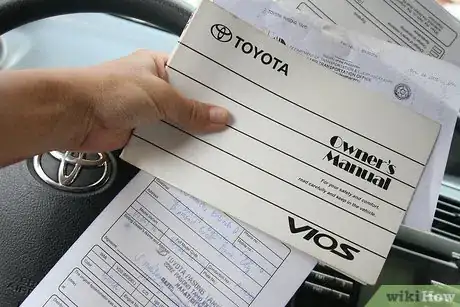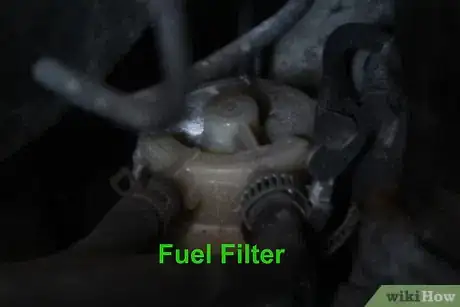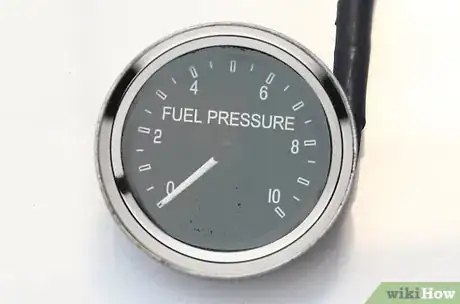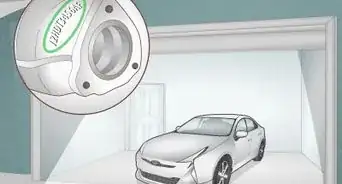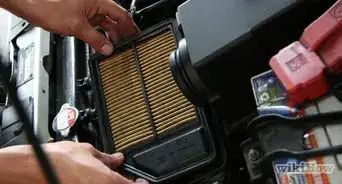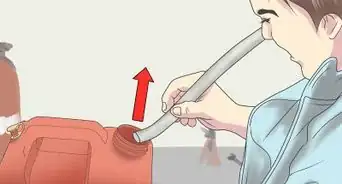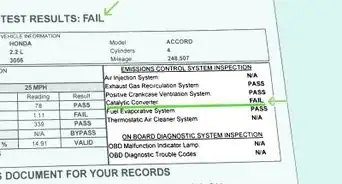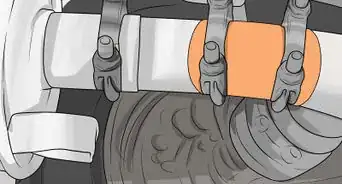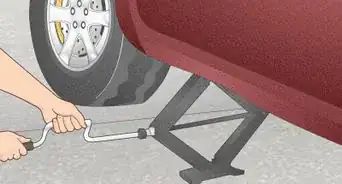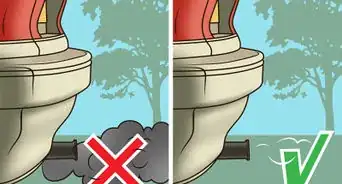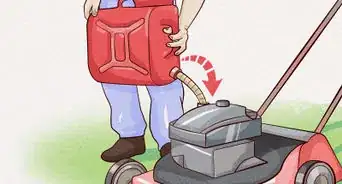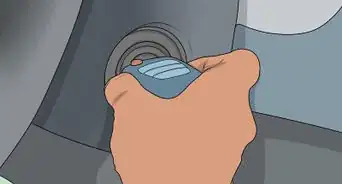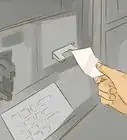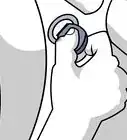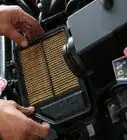This article was co-authored by Jay Safford. Jay Safford is an Automotive Consultant and Project Manager. He is Automotive Service Excellence (ASE), NAFA Fleet Management Association, Ford, and L1 Certified. He has over 15 years of automotive repair experience and has served as an Automotive Instructor at the Lincoln Technical Institute in West Palm Beach, Florida.
wikiHow marks an article as reader-approved once it receives enough positive feedback. This article has 12 testimonials from our readers, earning it our reader-approved status.
This article has been viewed 595,341 times.
If you're struggling to accelerate, especially on the highway, or you notice other signs your car might not be getting enough gas, the problem can be caused by a partially blocked or clogged fuel line, fuel filter, pump, or injector. If your car won't start at all, there are a few quick tests you can run to figure out whether or not it's causing your problems.
Steps
Performing an Electrical Test
-
1Check the fuel pump fuse. Often, it's not the pump itself that fails to function, but the power that supplies it. Check in your owner's manual for the location of the fuse box, then find the fuse that corresponds to the fuel pump. Pull it out and inspect it for signs of failure. If the fuse is blown, it will be broken or burned. If it looks good, check the rest of the fuses related to the fuel system for signs of being blown and replace them, if necessary. If no fuses are blown, have a helper turn the key while you listen for fuel pump relay clicking on.
- If you need to replace a fuse, make sure you use one with a proper amp rating, never installing one with more amps than necessary.[1]
- If you find a blown fuse, that might be a sign that you've got a high amp draw and you need to check the individual circuits.[2] Try to replace the blown fuel fuse and try and start vehicle. If the fuse blows again, a direct short is present and will need to be diagnosed. Take your car into the shop to get it checked out.
-
2Check the voltage at the pump itself. Just because you're getting juice from the circuit doesn't mean that it's getting to the pump itself, which makes it important to check the voltage there as well. Check out your vehicle's service manual to find out where to check and the proper procedure for checking it.
- Test for source voltage, to determine whether or not the good charge that's leaving the fuse is getting to the pump. If no power is making it to the fuel pump, then check the fuel pump relay circuit. You could have a bad relay.
Advertisement -
3Perform a drop test using a voltmeter. Check to make sure that the power wire shows the full voltage and the grounding wire shows that it's grounded properly. If this electrical test reveals nothing, it's likely that your fuel pump is the problem and it will need to be replaced, though you can check more thoroughly by completing an additional pressure test.
- If you show more than one volt difference, that means you've got a problem with corroded wires, or that you've got issues with the circuit on either the positive or negative side.[3] Take it into the shop for further testing and advice.
Performing a Fuel Pressure Test
-
1Eliminate the filter as a possibility. If the filter gets clogged with sediment, you can have trouble accelerating and might suspect your fuel pump has got a problem. To check it, remove the filter from the vehicle and drain excessive fuel from the filter. Use a short piece of rubber hose on the filter inlet. Blow through the filter inlet, paying attention to the resistance, which should be minimal. Inspect the screen for debris and replace the filter if necessary by blowing through the outlet side of filter into a white rag or towel.[4]
-
2Get a fuel pressure gauge. Commonly available at most auto parts stores for $20-30, a pressure gauge is a good investment, useful on most makes and models of cars. If you don’t want to buy one, you can also often borrow one from machine shops or auto shops who have them to lend. The test only takes a few minutes.[5]
-
3Hook the pressure gauge to the fuel pump test fitting. Locate your fuel pump test point, which is usually near the fuel injectors, and locate the point at which the pump hooks up with the filter injector rail. There should be a separation joint or a test port, where the pressure gauge attaches.
- Different gauges may have slightly different instructions, and the location of the fuel pump varies from vehicle to vehicle, so consult your owner’s manual for more specific instructions.
-
4Have a helper rev the engine while you check the gauge. Let the engine warm up slightly, then check the pressure both at idle speed and at the rated speed listed in your pump specifications. If you don’t know the rated speed, just rev the engine and see how the pressure reacts. If you have a serious problem, the needle won’t go anywhere or goes down below specifications, meaning the fuel pump needs to be replaced.
- The pressure should match the specifications listed in the repair manual, and should increase as you rev the engine. If it doesn’t, you need to replace your fuel pump and filter.
References
- ↑ https://www.familyhandyman.com/automotive/car-maintenance/replacing-auto-fuses/
- ↑ https://www.allaboutcircuits.com/textbook/direct-current/chpt-12/fuses/
- ↑ https://www.popularmechanics.com/cars/how-to/a4246/4314662/
- ↑ http://www.fuelpumpu.com/news-fuel-filter-inspection
- ↑ https://www.2carpros.com/articles/how-to-check-fuel-system-pressure-and-regulator
About This Article
Before you check your fuel pump, find the fuse that corresponds to the pump and pull it out to see if it is broken or burned. If it looks fine, check the voltage at the pump itself to make sure the charge that’s leaving the fuse gets to the pump. If this looks alright, then perform a fuel pressure test. Get a fuel pressure gauge, hook it up to the fuel pump test point, and have a helper rev the engine. If the needle doesn’t move or doesn’t move much, you found the problem. For more tips, including how to check the filter, keep reading our Master Mechanic reviewer’s advice!

